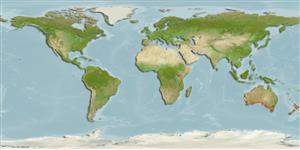>
Eupercaria/misc (Various families in series Eupercaria) >
Sparidae (Porgies)
Etymology: Acanthopagrus: Greek, akantha = thorn + Greek, pagros, a kind of fish (Ref. 45335).
Environment: milieu / climate zone / depth range / distribution range
Ecologia
marino; acqua dolce; salmastro demersale. Subtropical; 23°S - 44°S, 112°E - 154°E
Indo-Pacific: endemic to southern Australia.
Length at first maturity / Size / Peso / Age
Maturity: Lm ?, range 16 - ? cm
Max length : 60.0 cm TL maschio/sesso non determinato; (Ref. 2156); common length : 24.0 cm TL maschio/sesso non determinato; (Ref. 2156); peso massimo pubblicato: 4.0 kg (Ref. 26523); Età massima riportata: 29 anni (Ref. 36820)
Short description
Chiavi di identificazione | Morfologia | Morfometria
Spine dorsali (totale) : 10 - 13; Raggi dorsali molli (totale) : 10 - 13; Spine anali: 3; Raggi anali molli: 8 - 10. The upper body can vary from silvery to golden brown, bronze, green or black depending on habitat. Chin and belly are usually white and fins are dusky to greenish black. Dorsal and ventral profiles of adults are similarly convex.
Endemic in coastal areas, rivers and estuaries of Australia. Most abundant in river mouths and estuaries (Ref. 28468, 28472). Inhabit brackish waters of coastal rivers and lakes, occasionally penetrating fresh water (Ref. 44894). Considered as the only true estuarine sparid in Australia. Larvae and small juveniles are most abundant over seagrass beds in shallow estuarine waters (Ref. 28468, 28472). Spawning period varies considerably between estuaries (Ref. 28468). Remain upstream in sheltered waters to spawn and is not usually found in purely marine habitats (Ref. 44894). Feed on shellfish, worms, crustaceans, small fish and algae. Sold as whole, chilled products in domestic markets (Ref. 6390). One of top angling species in southern Australia (Ref. 6390, 44894), as well as being a delicious table fish (Ref. 2156).
It is not known whether there is any sex inversion in black bream (Ref. 6390).
Kailola, P.J., M.J. Williams, P.C. Stewart, R.E. Reichelt, A. McNee and C. Grieve, 1993. Australian fisheries resources. Bureau of Resource Sciences, Canberra, Australia. 422 p. (Ref. 6390)
IUCN Red List Status (Ref. 130435)
Threat to humans
Harmless
Human uses
Pesca: commerciale; Pesce da pesca sportiva: si
Strumenti
Special reports
Download XML
Fonti Internet
Estimates based on models
Preferred temperature (Ref.
123201): 14.7 - 20.6, mean 17.6 °C (based on 126 cells).
Phylogenetic diversity index (Ref.
82804): PD
50 = 0.5000 [Uniqueness, from 0.5 = low to 2.0 = high].
Bayesian length-weight: a=0.01259 (0.01140 - 0.01390), b=3.04 (3.01 - 3.07), in cm total length, based on LWR estimates for this species (Ref.
93245).
Trophic level (Ref.
69278): 3.5 ±0.53 se; based on food items.
Generation time: 4.1 (3.7 - 6.9) years. Estimated as median ln(3)/K based on 16
growth studies.
Resilienza (Ref.
120179): Basso, tempo minimo di raddoppiamento della popolazione 4.5 - 14 anni (K=0.11; tm=2-5; tmax=29).
Fishing Vulnerability (Ref.
59153): Moderate vulnerability (41 of 100).
Nutrients (Ref.
124155): Calcium = 76.4 [42.1, 142.3] mg/100g; Iron = 1.07 [0.62, 1.89] mg/100g; Protein = 20 [19, 21] %; Omega3 = 0.36 [0.25, 0.57] g/100g; Selenium = 21.1 [10.4, 38.9] μg/100g; VitaminA = 9.49 [3.31, 24.31] μg/100g; Zinc = 0.832 [0.594, 1.137] mg/100g (wet weight);
